John Siegenthaler: How to use a variable-speed circulator for boiler protection
Any boiler can become a condensing boiler under the right conditions.
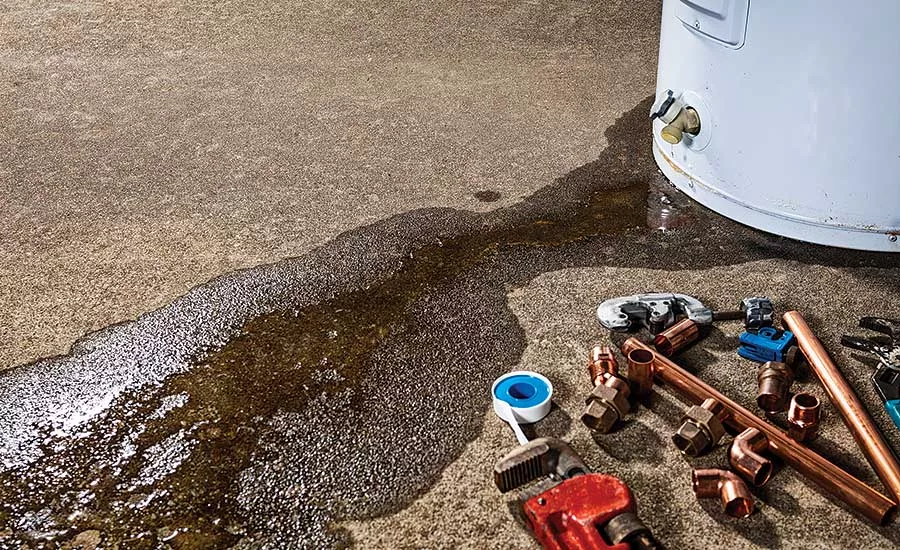
All boilers that burn hydrocarbon fuels (natural gas, propane, oil, wood) produce water vapor as a byproduct of combustion.
About half of the boilers currently sold in the U.S. are conventional boilers with heat exchangers constructed of cast iron, steel or copper tube. They’re designed with the intent of being operated at conditions that do not allow this water vapor to condense, on a sustained basis, within the boiler’s heat exchanger.
The two italicized words in the preceding sentence deserve further attention. Just because manufacturers of conventional boilers intend their boilers to operate at conditions that prevent sustained flue gas condensation does not mean these boilers cannot condense. As Don Pratt, a former trainer at Mestek, once told an audience of aspiring hydronic professionals, “Any boiler can be a condensing boiler.”
That statement drew its share of confused looks, but it’s 100% correct. There is no such thing as hydrocarbon-fueled non-condensing boiler. Given a suitably low incoming water temperature, any hydrocarbon-fuel boiler will operate with sustained flue gas condensation. In addition to boiler corrosion, that condensation can quickly destroy galvanized steel vent connector piping — and even masonry chimneys.
The word sustained is also important. All hydrocarbon-fueled boilers experience intermittent flue gas condensation following a cold start. It happens because the combustion side of the boiler’s heat exchanger is well below the dew point of the water vapor in the exhaust gas stream. However, a properly designed balance-of-system allows a conventional boiler to quickly warm its internal surfaces above dew point and evaporate that initial condensation to prevent it from reoccurring over the remainder of the burn cycle. Short-lived intermittent flue gas condensation is not a problem.
Staying above the dew point
The key to preventing sustained flue gas condensation is keeping the inlet water temperature above the dew point of the combustion gases whenever possible. Most “legacy” hydronic systems did this by selecting and sizing heat emitters that required water temperatures of 180° F or higher to dissipate the boiler’s rate of heat production.
However, many modern hydronic systems are designed around much lower water temperatures. In some cases, modern hydronic systems also contain components having much greater thermal mass compared to their finned-tube predecessors. A heated concrete floor slab is a good example. So is a system with a larger thermal storage tank.
Does this mean conventional boilers cannot be used with low-temperature heat emitters or high-thermal-mass systems? Absolutely not. There are plenty of options for mixing assemblies that reduce water temperature on the supply side of the system. However, as the North American hydronics industry sometimes painfully learned when radiant panel heating was resurrected in the 1980s, it’s just as important to pay attention to what’s happening at the boiler inlet.
When a hydronic heating system contains lots of thermal mass, there will be times when the rate of heat absorption by the balance-of-system (everything in the system other than the heat source) can absorb heat from circulating water at a rate much higher than the rate of heat output by that heat source.
A good example that some readers have undoubtedly witnessed is when warm water is circulated through a cold concrete slab during a cold-weather startup. Assume the slab is initially at 45°, and water at 110° is pumped into the embedded circuits at the same flow rate that would be present at design load. Under such conditions, it’s not unusual for the water exiting the slab to be at perhaps 55°.
That condition represents a temperature drop of 55°, almost three times greater than a typical design load temperature drop of 20°. Three times the ∆T at the same flow rate implies three times the rate of heat absorption. That cold slab is acting like a black hole for Btu; it’s absorbing heat from the water stream much faster than the boiler can create heat, even when that boiler is running flat-out.
If allowed to occur, this condition can return water to the boiler at temperatures well below the dew point of the exhaust gases. Copious condensation will occur. If you’re standing close to a gas-fired cast iron boiler operating under such conditions, you might even hear condensate dripping from the bottom of sections onto the burner tubes.
This condition isn’t limited to gas-fired boilers. I’ve known of oil-fired boilers that have dumped multiple quarts of water on the floor when their combustion chamber door was opened after several hours of condensing mode operating. This is not what the boiler manufacturer intended.
Thermal clutches
The only way to consistently protect against such a condition is to create a way for the boiler to thermally uncouple itself, when necessary, from that heat-guzzling balance-of-system. You’ll need a thermal clutch that can fully regulate the rate of heat transfer from the boiler to the balance-of-system.
In a vehicle, a mechanical clutch regulates mechanical energy transfer from the engine to the drivetrain. When the clutch pedal is fully depressed, the engine and drivetrain are uncoupled. When the clutch pedal is partially depressed, there is some mechanical energy transfer from the engine to the drivetrain.
When the clutch pedal is fully out, there is maximum coupling between the engine and drivetrain. This allows the drivetrain to receive mechanical energy at the same rate the engine is creating it.
A thermal clutch is analogous to a mechanical clutch. The difference is that it regulates the transfer of thermal energy rather than mechanical energy.
To consistently protect a boiler from sustained flue gas condensation a thermal clutch must provide both of the following functions:
- Function No. 1: It must sense and react to boiler inlet temperature.
- Function No. 2: It must allow the boiler’s heat output to be fully uncoupled from the load when necessary.
There are several piping assemblies and associated controls that can provide both of these functions. There are also piping assemblies that some practitioners assume provide these functions but in reality fall short.
Misunderstood
Two piping assemblies that have been used in North American hydronics for decades, and sometimes for the wrong reasons, are shown in Figures 1 and 2.
FIGURE 1.
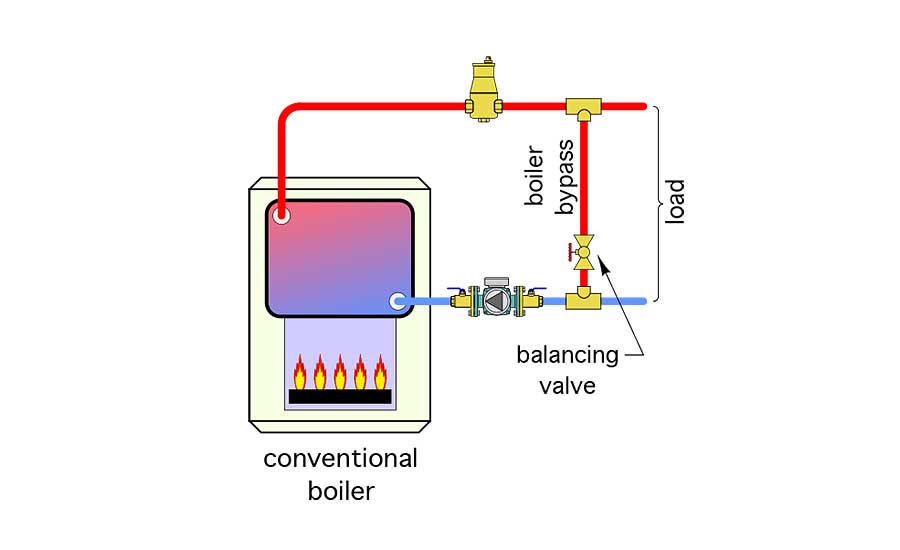
These piping assemblies are called boiler bypasses. The one in Figure 1 bleeds what is assumed to be hot water from the boiler outlet through the bypass pipe, forcing it to mix with cooler water returning from the distribution system. A balancing valve is used to adjust the bypass flow rate. The assembly in Figure 2 uses a dedicated circulator to create the bypass flow.
FIGURE 2.
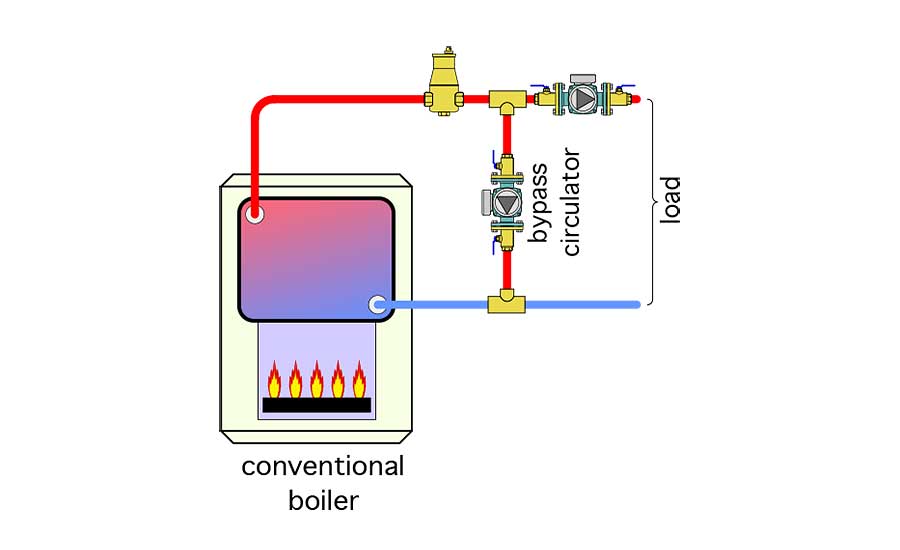
For decades, these piping assemblies have often been viewed as capable of passing sufficient hot water from the boiler outlet into the lower tee, where it mixes with water returning from the load to boost boiler inlet temperature above the dew point of the flue gases. In some systems — those with high-temperature/low-mass heat emitters and generously oversized boilers — these piping assemblies usually worked acceptably well to limit flue gas condensation. They also reduced thermal shock to cast iron boilers.
Still, as hydronic systems evolved toward low-temperature/high-mass characteristics, neither of these piping assemblies were able to satisfy the two previously stated and required functions. Neither could react to boiler inlet temperature, and neither could fully uncouple the boiler from the load when necessary.
Consider what would happen with either of these piping assemblies when the water temperature returning from the load was 95°. Assuming a typical boiler flow rate, the temperature rise across the boiler would be about 20°. That makes the “hot” water leaving the boiler 110°.
Question: How do you mix 110° water with 95° water at the lower tee to produce the 130° water needed to prevent flue gas condensation? Answer: You can’t. It’s impossible.
The bottom line: Boiler bypass piping, as shown in Figures 1 and 2, cannot consistently protect conventional boilers from operating with sustained flue gas condensation.
A simple rearrangement
Given this deficiency, one might assume that making the boiler bypass circulator in Figure 2 a variable-speed circulator that responds to boiler inlet temperature would remedy the situation. It would satisfy function No. 1, but not function No. 2.
Fortunately, a simple modification of the piping in combination with a temperature-regulated variable-speed shuttle circulator can provide both functions needed to prevent sustained flue gas condensation. That modification is shown in Figure 3.
FIGURE 3.
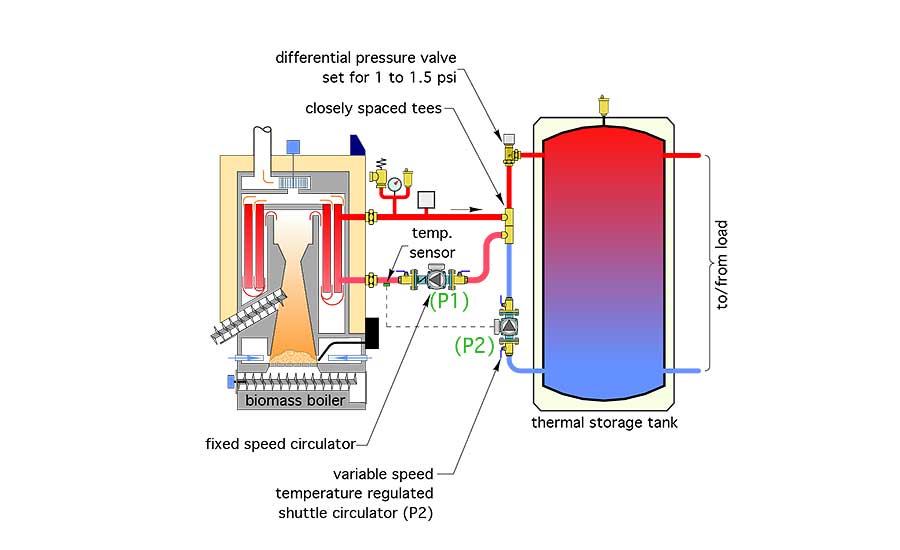
The load in Figure 3 is a large thermal storage tank. An example would be a multi-hundred gallon tank heated by a pellet boiler or cordwood gasification boiler. When such a tank has not received heat for an extended period it represents a very significant cool thermal mass.
When the boiler in this system is called to operate, circulators (P1) and (P2) are both powered on. Circulator (P1) establishes a fixed flow rate through the boiler. The variable-speed shuttle circulator (P2) monitors boiler inlet temperature. When that temperature is below a preset value (typically around 130° for gas-fired boilers and 140° for cordwood gasification boilers), the variable-speed shuttle circulator is powered, but its motor remains off. Under this condition, the flow created by circulator (P1) does a U-turn at the closely spaced tees and returns to the boiler. This prevents all but a trickle of heat transfer between the boiler and load, effectively uncoupling the two.
As the boiler inlet temperature rises above the set point, the shuttle circulator speed increases, allowing increased heat transfer to the load. When the boiler inlet temperature reaches 5° or more above the set point, the shuttle circulator is operating at full speed. If some condition then causes the boiler inlet temperature to drop toward the set point, the shuttle circulator slows to reduce the rate of heat transfer. This action allows all the heat produced by the boiler to be shuttled to the load, but doesn’t allow the load to dominate the process by creating a rate of heat absorption greater than what the boiler can sustain. The thermal clutch is being perfectly controlled.
Not so fast
The above description assumes the shuttle circulator is completely off when the boiler inlet temperature is below the preset threshold value. There are some circulators with integral temperature controllers as well as circulators that can be regulated by external controllers that will operate this way.
However, some variable-speed circulators must operate at a minimum speed whenever they are powered, which would be anytime the boiler is called to operate. In this case, it’s important to have a device that provides some forward opening resistance in the load circuit to prevent flow when the circulator is at minimal speed. A differential pressure valve set to a forward cracking pressure of 1 to 1.5 psi can usually provide this requirement. That valve will also fully close to prevent reverse thermosiphoning from the tank through the boiler piping when the boiler and circulators (P1) and (P2) are off.
Some readers will recognize this method of boiler protection is just a “subset” of variable-speed injection mixing. If the thermal storage tank in Figure 3 was replaced by another set of closely spaced tees and a high mass distribution system, the system would look similar to Figure 4. This approach to boiler protection and regulation of supply water temperature has been used for more than 20 years in North American hydronics.
FIGURE 4.
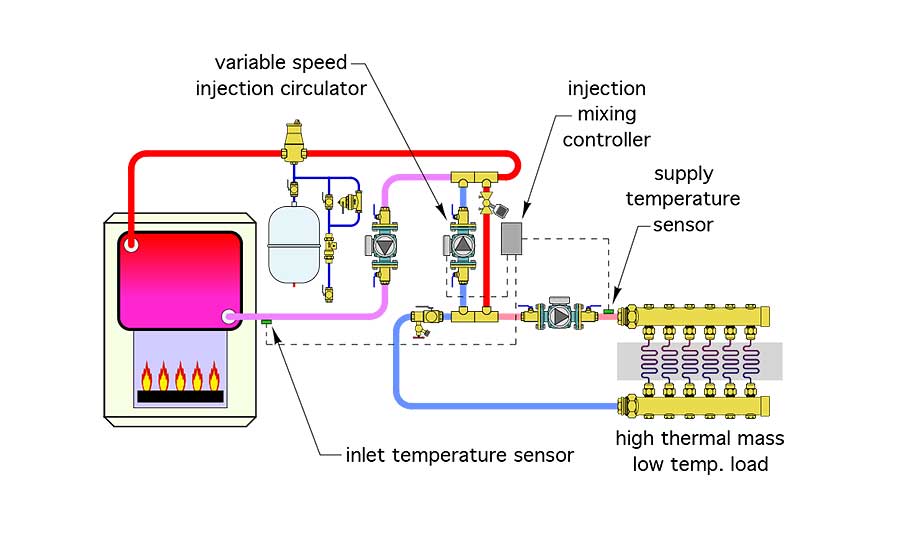
In addition to a variable-speed shuttle circulator, there are several other piping assemblies and associated controls that can protect conventional boilers from sustained flue gas condensation. They include systems using motorized two-way, three-way and four-way mixing valves as well as systems with specifically configured thermostatic mixing valves. Designers contemplating the use of such assemblies should remember that consistent boiler protection requires these assemblies to provide both of the following functions: No. 1, it must sense and react to boiler inlet temperature; and No. 2, it must allow the boiler’s heat output to be fully uncoupled from the load when necessary.
To read Siegenthaler’s article: “How to use a variable-speed circulator for boiler protection” in pdf form, please see here.
Looking for a reprint of this article?
From high-res PDFs to custom plaques, order your copy today!








